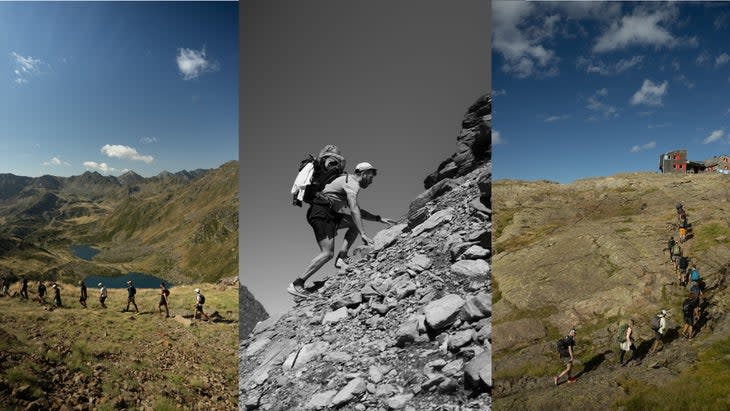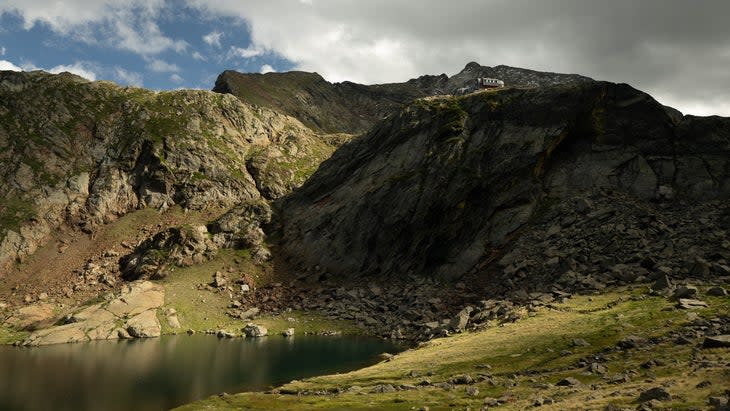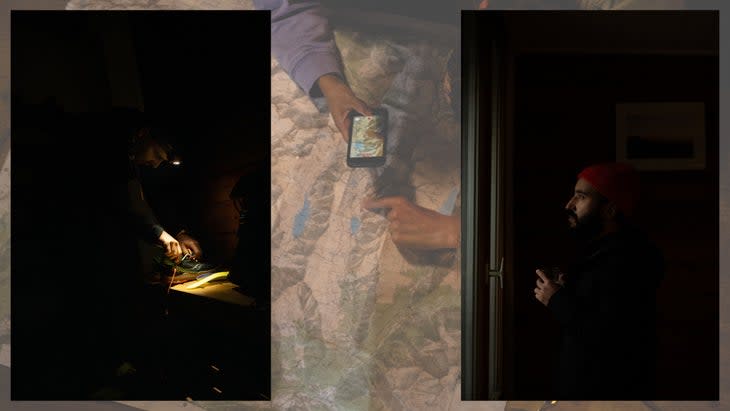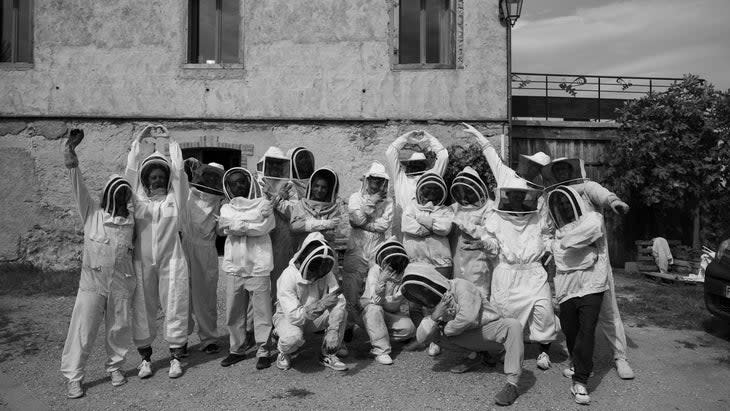This Unconventional Retreat in the French Pyrenees Offers More than Miles
- Oops!Something went wrong.Please try again later.
This article originally appeared on Trail Runner
Early morning in the Ariege Pyrenees in southwest France offers an exhale of sherbert-colored light that colors the horizon. Daybreak glows over granite and volcanic rock jutting from the surface of the earth. The air is refreshingly cool; life here is wild, remote and still.
If you can get here, a dose of this serenity is a reward. That is part of the challenge seven miles away for a group of 15 runners from all over the world as they plunge their feet onto the serrated terrain, carefully surveying the ground with each step. They'd gathered two days ago in Toulouse, France, introducing themselves by first name and astrological sign.
"You can call me Mau," said Mexican ultrarunner Maurcio Diaz, adding, "Aries, a lot of fire!"
He is here with the group as part of a weeklong retreat in the Gaudies region of France, hosted by Aire Libre, a running brand cofounded by Diaz in Mexico City, in 2018, with creative partner and photographer Daniel Almazan Klinckwort.
The idea behind Aire Libre ("free air," in Spanish) is to bring runners off-road and into nature through curated trail running and hiking excursions led by local experts, often weaving in a spiritual dimension. It encourages each person to simultaneously disconnect and reconnect.

A Good Kind of Crazy
"It's a different way to appreciate running," Diaz says. Soft-spoken with a thick, dark beard that envelopes half of his face, Diaz is the good kind of crazy, a man whose reserved demeanor doesn't reveal his outrageously adventurous side.
One time, he ran 56 miles with a few friends, starting at 5:30 A.M. across the Sonoran desert in northwestern Mexico, a desolate area that is home to the Indigenous Seri people. The ultra was not a competition. Rather, it was a self-induced challenge--a dangerous one, too. Diaz intended to run two marathons back-to-back in stifling heat across 13 hours on a route known now for drug trafficking. There was a moment when he began to break down from excruciating pain in his knees and calves; he didn't know if he could endure another step. Diaz was ready to quit until a Seri leader, who had been escorting the runners, began chanting and playing instruments as part of a ritual.
By the end of the journey at the Sea of Cortez, where Diaz plunged into cool saltwater, he had a born-again moment with running. Rather than being absorbed by splits on a watch, or Strava, or collecting a race medal, what if running could be a means to understand that nature and movement are essential for one's life and happiness?
The question seeded his motivation to discover more of the world through running, and to bring others along the journey. Diaz brought it to life with Aire Libre, a series of mindfulness and cultural running retreats around the world--among them in the Andes Mountain Range in Peru, Chile's Lake District on the northern tip of Patagonia, on ancient trails in Oaxaca, Mexico, and high into the mountains of the Pyrenees in France.
Playground Amid the Peaks
Stretching 270 miles along the French-Spanish border, from the Mediterranean Sea to the Atlantic Ocean, the French Pyrenees appear unblemished by human touch. The landscape, anchored in the Occitanie region of France, is a palace of emerald valleys and lakes adjacent glacier streams that offer a sort of white noise lullaby. Wild goats freckle the narrow ridges, unfazed by the high altitude, which can exceed 10,000 feet.

Thirty-four-year-old Thomas Galpin, the mountain guide for this retreat, lives on the outskirts of Toulouse and describes the Pyrenees as more rugged and rustic compared to the better-known French Alps. After a decade of spending weekends running and hiking in the Pyrenees, Galpin, he decided to solo-traverse 500 miles across the whole mountain range in 30 days in 2019.
"This is my garden," he tells the group of mostly late 30-something men and women.
Many here have already participated in at least one previous Aire Libre retreat, drawn back by the power of the experiences. You know what you're getting yourself into, a few of them say.
RELATED: Is Hut-to-Hut Running on Your Bucket List? It Should Be.
Galpin will lead the group along today's route, considered the most demanding in Ariege: seven miles with 4,000 feet of elevation gain. The participants--from as far away as San Francisco, Chicago, and Mexico City--stand at the beginning of the unnamed route, marked with two perpendicular white and red lines. The singletrack trail leads to Mont Fourcat, where the peak offers a sweeping view of the upper Ariege.
Diaz had told the group at the start of the hike, "This trail is like a door. We are entering a space that will be our playground. I like to talk to the Earth, touch the ground." Consider setting an intention, Diaz encouraged. "It's important to establish a connection with the land." Silence followed as each participant closed their eyes. A few people knelt down and imprinted their hands on the dirt or cradled a rock.
Galpin sets a leisurely pace that will bring the group to the top of Mont Fourcat in six hours. "It's hard to explain what it gives you," Galpin says as he begins a sweat-inducing saunter up the steep incline. "But it's very pure. You have to be patient and grateful with the environment."
Though the retreat, which includes hiking, trail running, and yoga, is classified as "intermediate" level on Aire Libre's website, the fitness and athletic abilities of each participant ranges widely. To maintain cohesiveness, Galpin takes several breaks, including a picnic with saucisson and brie sandwiches dabbed with homemade hummus.
Each person carries two days worth of essentials loaded onto their backs. They will basecamp at Refuge du Fourcat, the highest refuge in Ariege, at 8,021 feet, and will explore the surrounding peaks and trails, one of which threads south into Andorra.
Extended Family
The scent of salt, fat, and carbs wafts through the air early evening as the group lumbers onto a wooden deck, finally arriving at the refuge. It no longer feels like summer. Rather, a blanket of fall meets winter. Up here, the mountains look otherworldly.
"We're a step closer to heaven," says Dan O'Brien, 30, a senior manager of financial planning from Chicago, who came along for his second Aire Libre retreat.
"Bonjour," says Lolo, a scruffy-bearded man, as he snubs out a cigarette while jamming to rock and roll music on a radio. Lolo is one of three guardians at the refuge. He remains onsite in 10-day increments, cooking and cleaning for guests. The lodging is open from the end of June until mid-September, and it's so remote that the majority of supplies are delivered four times a year, via helicopter.
"This place is completely Wes Anderson-esque," Diaz says as he walks to the front of the refuge's beautiful exterior--part chocolate brown wood paneling and stone with red-orange shutters. Everyone removes their dirt-caked shoes before entering. Crocs are available for guests, shelved by the doorway.
Inside serves the kind of chill that requires a jacket at all times, especially to sleep. A source of warmth is rationed as one four-minute hot shower per guest per day before the water automatically shuts off. Solar power keeps the electricity on during the day, but headlamps are the only light source at night, used also to find one's way to their bed in one of nine bunk-style dormitories, outfitted with twin-sized mattresses that are spaced inches apart.

After everyone settles, beer and red wine flow as they sit around wrapped in wool blankets, appearing euphoric yet dazed. Lolo prepares lentil soup, ratatouille, and beef stew that will precede a cheese plate and a pear tart. Over dinner, a question is posed: Why are you here? What compelled each person to shell out $2,500--the price tag sans flight--to partake in this physically demanding escape from their daily realities?
Diaz recognizes that the demographic of Aire Libre retreats trends toward groups of mostly single individuals in their late 30s with disposable income. But he shares that the retreats are also certainly not designed to be an exclusive experience. He is working to shift this narrative with partnerships and grants as a way to offset the costs and offer complimentary spots for people without the financial means to participate.
For now, many participants are those who have the means to explore corners of the world they wouldn't feel comfortable traveling to solo. One runner comments that these retreats are a way to meet friends with similar interests that don't only revolve around children.
"There is something special about the combination of wonderful people from all over the world, while pushing yourself to new limits and discovering parts of the world you could only see from exploring on foot," says Shelby Rhodes, a chief of staff for YouTube in California. This is her third Aire Libre retreat.
"The challenge of doing something I'm scared of," says Jacqueline Arroyo, a hair designer from Mexico City. "That's what makes the experience beautiful."
Another participant, Julie Morill, an international emergency preparedness consultant from Virginia, uses the term "Type 2 fun," that sweet spot of suffering in the moment that afterward recasts into a sense of accomplishment.
And for Stefan Fiebig, a software project manager from Hamburg, Germany, it's to seek meaningful connections that he can't seem to build in the commercial running landscape, where lucrative sponsorships from multi-million dollar brands influence the experience, and can make the running experience feel less intimate. He thinks Aire Libre is a welcome contrast, a non-corporate way to connect to the sport, and now the retreats are how he prefers to travel. "It feels like family when you're on one of these trips," he says.
The retreats are indeed tight-knit, with an average of 15 participants. Diaz comments that the experiences tend to attract open-minded individuals ready for a challenge-perhaps even an epiphany. "Whoever comes is probably at a point in life where they're going through X or Y," he says. "Much of the time it has to do with self-discovery."
RELATED: This Retreat Is Helping Support Women of Color in the Running Industry
Running as Harmony
Two days after ascending Mont Fourcat, followed by a 10-mile run-hike over the Tristagne mountain range the next day, the group is ready to lay still. Full-body soreness has left many in need of a more gentle activity. But first they must retrace their footsteps down the mountain--another four hours of walking, after which they arrive at a parking lot where they left two vans. The group drives off on a traffic-less road that slices through sunflower fields. Within an hour, the vans pull into a gravel driveway surrounded by French and English lavender that leads to Zero Neuf, an 18th-century stone farmhouse that is the base for the duration of the trip.

The property, formerly a working dairy farm until the 1970s, was purchased and restored in 2014 by a British couple, Mike and Joss Tucker, who now operate it as a bed and breakfast, often hosting cycling, running and wellness retreats throughout the year.
Local instructor and mountain guide-in-training Solenne Gauthier meets the group to lead a yoga session, while each runner rolls out a mat onto the grass outside the farmhouse. Aire Libre retreats incorporate various practices like this to weave mindfulness into the running component. Some practices are specific to the locality--like offering a temazcal ceremony in Mexico--while each ritual is integrated as a means to help each person feel grounded and present, Diaz says.
The retreat ends with an immersive surprise visit to La Grange aux Abeilles, a honeybee farm operated by Anne Kneur-Didier. She welcomes the group into a room and allocates various white bee suits. Then, Kneur-Didier leads a walk down to dozens of dark wooden boxes full of hives. She has a favorite, lifting a tray covered with thousands of bees. This particular hive is more cooperative, she explains, as she uses her bare hands to pick up the queen bee tagged with a green sticker. Bees circle and buzz, clinging onto everyone's clothing, and yet, there is a serenity at play among the two-legged ones and the winged ones.
Perhaps running is just the excuse, and that what really brought everyone here on this running retreat is to better understand a life best understood in harmony.
For exclusive access to all of our fitness, gear, adventure, and travel stories, plus discounts on trips, events, and gear, sign up for Outside+ today.

